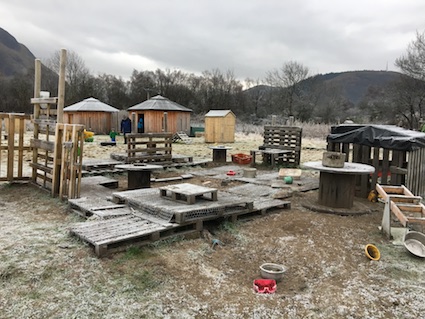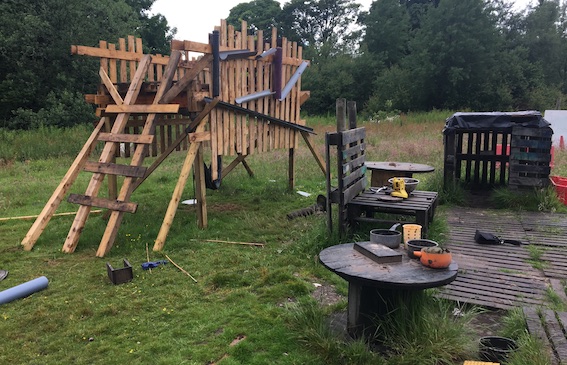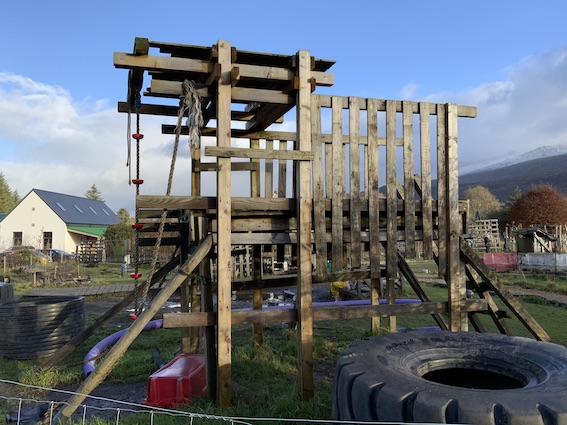
Pallets are “in” in the world of outdoor play. And Stramash outdoor nurseries are up there in terms of the creative constructions which are appearing in nurseries across the world. In 2016 at Fort William this amazing play station was developed. In the words of Cameron Sprague, Team Leader, “It’s all very simple, but the variety of levels, open-ended areas, and its suitability for adding loose parts lead to real world learning and social opportunities.“

The aim was to create a place where mud play was more than digging and more than a mud kitchen. The staff wanted a space where children could:
- Move and explore at different heights – check out the vertical pallets that have been attached to heavy duty poles, enabling children to climb up and over or simply sit on top. To put water into the water wall, a child has to climb up there to get it in. In the top photo – look at the bridge of pallets. There is a channel under the bridge on the right side of the first pic as well so children can introduce water into the billabong and others can stand on top and watch it come through as well.
- Begin to understand the concept of depth – digging into the ground is the beginning of understanding the concept of “below ground level” and that zero is another number on a vertical number line.
- Experience and follow the flow of water. From the water wall channels are created so that the water flows away down the slight gradient, under a palette and gathers temporarily in a little mud billabong. You can see a couple of buckets in the foreground of the photo below where this is. Also, if you look carefully between the pallets, you will see a blue pipe that is angled from the water wall. If the children want water to flow through that they need to purposely transport the water into it. It is just another opportunity to explore the flow of water that’s left open-ended for them to discover.
- Have space to move. The area can accommodate lots of children moving in through and around it. In the photo below, you can just see the kitchen table that provides a different height for mixing and manipulating the mud.
- Socialise on their terms. There’s also a pallet den on the right hand side providing privacy and seclusion in an open area for private conversations and play.
- Enjoy investigating the mass of different objects. There’s a giant bucket weighing scale created from an old bunk bed ladder that is on hand when the children need to compare how heavy or light something is.

Like all good outdoor spaces, this area is constantly changing in line with the children’s interests and to ensure that any weakened structures are promptly sorted. You can see from the wear and tear it’s a much loved play space. This is true of any given space – there should be an ebb and flow of activity. One year later in November 2017 you can see the water wall on the right now has a pallet den added:

The water wall had also been changed. More guttering had been added. However it is only “semi-fixed”. Many of the pieces could be tilted like a seesaw. This had been achieved through carefully screwing the guttering onto the pallets in the centre. This enabled the younger children, especially the two year olds to examine cause and effect.

When I visited a few months later, changes were afoot, Cameron said:
“We actually just took the water wall down but we are hoping to rebuild with a more child led design as the elements of the wall were never something we all were happy with. We have been donated a sink which I’m hoping to get one of those Cosy water pumps hooked up to as well as some valves for the drainage pipe that children can open and close depending on their play.“

In the above photo you can see that six months later another structure has been co-created by children and staff. This is a much bigger water wall where the height of the structure is significant.

This larger water wall continued to grow and change. By November 2021, it looked very different and the guttering had disappeared.

You can see there are now fixed ropes in place and it’s become much more of a climbing up and jumping off structure. The photo below gives you a sense of height with the child getting ready to jump into Cameron’s arms and her contemplating the possibility.

As for the rest of the pallet play station, like all nurseries, there is shelf life to structures. They need regular checks and maintenance. But also they need to be relevant and serve the needs of the current cohort. In November 2021, the space changed again – almost beyond recognition. But it continues to evolve and grow.

When you look at your own outdoor space, can you track the changes which happen and know the story of the place? Documenting the changes and involving your children in the process deepens the the sense of connection between space and time.
- For more advice about these constructions, please see the Loose Parts Play Toolkit.
- If you are looking for information about the safety and suitability of pallets for your projects, have a look at Pallet 1001’s advice here.
- Cameron and other Stramash staff run training course about building structures and growing an outdoor space. Please get in touch with them for more information, if interested.
This blog post was originally published in March 2017.




















Trackbacks/Pingbacks